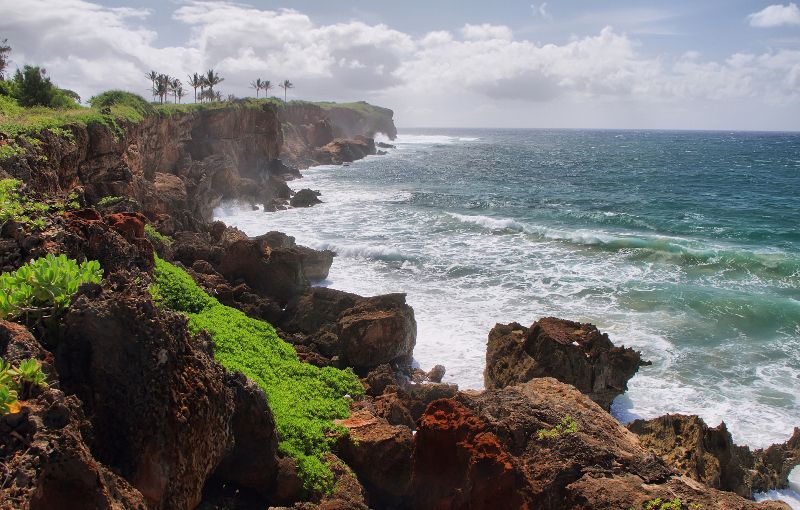Exploring life-sized sandcastles millions of years in the making is a unique experience available to Kaua‘i residents and visitors. A hike along the Mahaulepu Heritage Trail will help you tap into your inner Indiana Jones! You can step into Hawaii’s largest limestone cave, where paleontologists have unearthed fossils dating back some 10,000 years. The joys of trekking this Kaua‘i trail are endless, as it hugs an undeveloped coastline unlike any place else in the world.
To reach the craggy limestone spires and time-worn sand dunes of this South Shore coast, head toward the end of Poʻipū Road. The trail begins at Keoneloa Bay or Shipwreck Beach, nicknamed after a demolished fishing boat that was discovered here during the 1970s. This is a popular spot for surfers to paddle out, especially during summer when the South Shore swells are rolling in almost daily. Several footpaths proceed to wind along the coast from here. For the most dramatic vistas, carefully venture to the path furthest to your right to gain full advantage of the sweeping scenery on what you can expect to be a 4-hour, round-trip hike.

Lithified sand formations and dramatic tides encompass this region, and as you continue traversing across dunes near the cliff’s edge, be on the lookout for native seabirds, honu (green sea turtles), as well as kohola (humpback whales). Along the trail, you’ll discover all kinds of geologic wonders—like the spikey towers of sandstone created from centuries of rainwater runoff, where paleontologists have revealed the large bones of ancient, flightless birds that once roamed the island. At the midway point of the hike, you’ll find Makauwahi Cave, Hawai‘i’s largest fossil site. This giant sinkhole’s formation began an estimated 400,000 years ago, and an eventual ceiling collapse of the hardened sand cave left behind a lake, where petrified specimens have been well preserved for centuries.
Animal bones, seeds, shells, and burnt wood are among the many relics that have been uncovered here, helping paint a picture of what life was like on Kaua‘i both before and after human contact. Pits dug deep into the earth by scientists have uncovered many findings. These include 400-year-old coral fragments that provide evidence of a tsunami that reached the island in 1586, stemming from an earthquake that is known to have originated in the Aleutian Islands that year. The Makauwahi Cave Reserve is open sporadically during the week but most frequently on Sundays from 9 a.m. to 2 p.m., when free, guided tours are offered. You can check out some of the fossils that have been unveiled at this site over the years and learn more about Kaua‘i‘s unique archaeologic and paleontological history during your visit.
As if this weren’t enough, the cave is located next to Māhāʻulepū Beach, a great spot to relax and find some shade before heading back. The sunny South Shore of Kaua‘i is home to many stunning vistas and opportunities for fascinating adventures. There’s nothing quite like its jagged golden bluffs and sandy citadels in the entire state of Hawai‘i.
For more information about the Mahaulepu Heritage Trail and Makauwahi Cave Reserve, please visit hikemahaulepu.org or cavereserve.org.




 Would you buy a house so perfect it could be located in San Diego, down the street from Disneyland …
Would you buy a house so perfect it could be located in San Diego, down the street from Disneyland … If you’re planning to look at property while you’re on vacation in Hawaii, there’s one mistake you don’t want …
If you’re planning to look at property while you’re on vacation in Hawaii, there’s one mistake you don’t want …
Leave your opinion here. Please be nice. Your Email address will be kept private, this form is secure and we never spam you.